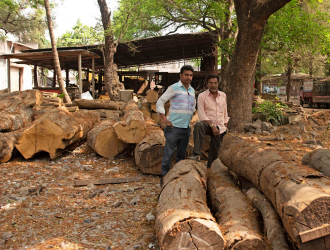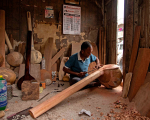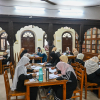Miraj is a historic town located in Sangli district of southern Maharashtra. This region, bordering Karnataka, has been at the epicentre of a thriving musical tradition for the last 150 years. Many of India’s top musicians, music bands and orchestra artists get their musical equipment repaired, designed and specially constructed by the legendary sitar-makers of Sitarmaker Galli. Sitarmaker Galli was officially named Faridsaheb Sitarmaker Marg by Miraj Municipality in honour of Faridsaheb Sitarmaker, who is considered to be the founding father of the local musical instrument industry.
Faridsaheb belonged to a family of Shikalgars (alternately Shikilkar), who traced their arrival in Miraj to the time of the Bijapur Sultanate under the Adil Shahis in the 17th century. The Shikalgars are a community of metalsmiths specialising in repairing arms and armour, and other military equipment. In the 18th century, Miraj came under Maratha rule, ultimately splitting into two jagirs in 1820: Miraj Junior and Miraj Senior. The end of the Anglo-Maratha Wars ushered in a period of peace and during this time, two major shifts happened—one socially and the other, technologically—which had a long-lasting impact on the town’s cultural history.
The technological shift was the increasing adaptation of firearms by the Maratha army and reducing demand for older military equipment, which was now considered obsolete in an era of mechanised warfare. Due to a declining market, the Shikalgar community had shifted to carpentry, making household items like knives and scissors.
The social shift was the patronage of the ruling Patwardhan dynasty for singers and musicians. Shrimant Balasaheb Patwardhan II (1866-1939) was a noted connoisseur of music and invited musicians from across the subcontinent to perform in Miraj. Miraj soon became a reputed centre for Hindustani classical music, and had a significant influence in the development of the Kirana gharana. Many famous exponents of the Kirana gharana, like Ustad Abdul Karim Khan, settled and taught in Miraj. Miraj is also associated with the work and career of famous singers and music teachers like Pandit Vishnu Digambar Paluskar, Pandit Balakrishnabuwa Ichalkaranjikar, Sawai Gandharva, Pandit Vishnu Narayan Bhatkhande, Hirabai Barodekar and Saraswati Rane.
Faridsaheb was born in Miraj in 1827 and grew up in a thriving culture of music. He regularly attended jalsas and mushairas in town. Till that time, sophisticated musical instruments were made in North Indian cities like Jaipur, Gwalior, Varanasi and Lucknow, which had a long history of reputed musical gharanas (schools). Bards and professional storytellers in the Deccan, particularly in Maharashtra, used relatively simpler instruments like the ektara and tamburi. These were lightweight and could be easily carried by itinerant musicians to perform in temples and villages. Attracted by the patronage of the Patwardhans, singers and musicians from the North Indian gharanas flocked to the court in Miraj; but they had no place to repair their instruments locally. They approached Faridsaheb for making repairs and he took this task upon himself with much devotion and dedication because of his deep love for music.
Faridsaheb was keen to understand the science of acoustics and was systematic in his approach. During the repairing process, he used to open the instrument and do a thorough study of its anatomy. He also made a record of the construction techniques, sound quality and type of materials used in the making. With this understanding, he started looking for similar materials in Miraj. Faridsaheb noticed how itinerant Hindu sadhus used gourds to make kamandalas and he got the idea that gourds can make an excellent raw material for resonators used in stringed musical instruments like sitar, veena and tanpura. He was helped by his brother Moinuddin, and together they started experimenting with new materials to make repairs and also make instruments from scratch. After many years of trial and error, they were finally successful in perfecting the acoustics which were highly valued by musicians. He was particularly credited for his fabulous work on refining the ‘javari’ which affects the tonal quality of strings on a sitar or tanpura. Faridsaheb was held in great esteem and musicians would often visit Miraj and wait for months, while he repaired their damaged instruments.
Faridsaheb died in 1898 at the age of 71. In his lifetime he received many accolades and certificates of honour from native rulers, British officials and music academies for his skilled craftsmanship. His legacy was continued by his son Abdul Ghani and his grandson Hussainsaheb. The spirit of entrepreneurship started by Faridsaheb 150 years back has now blossomed into a global market. Indian maestros like Pandit Ravi Shankar and Ustad Vilayat Khan got their equipment custom-made from Miraj, even giving their names to the distinct styles of sitars sold today. Based out of a single lane, today’s sitar-makers are the seventh generation practising the craft.
When I went to Miraj to document the sitar-making process, I was surprised to find that many of the techniques and materials developed by Faridsaheb and Moinuddinsaheb are still used in modern times by their descendants. The instruments are made entirely by hand and involves little or no use of power tools or mass production. The workshops are small, and everyone works in close proximity to each other, constantly exchanging information between themselves and overseeing each other’s work. Many aspects of the craft are intangible knowledge which an artist learns through years of hands-on experience and sharing nuances with generations of family members. Sitar-making is a very individualised craft, which combines the sensibilities of both the artist playing it and the craftsman making it. Every sitar player has a different requirement and the sitar-makers are quick to understand and execute that requirement to perfection. Since Faridsaheb, the success of Miraj’s craftsmen has been greatly due to the high quality standards, insightful knowledge and love for Indian classical music, which is reflected in every piece of instrument they make.

















